
Brave Women Have Been Immortalized in Statues Throughout the Finger Lakes
BRAVE WOMEN HAVE BEEN IMMORTALIZED IN STATUES THROUGHOUT THE FINGER LAKES

As you journey throughout the Finger Lakes region, you’ll come across sites from monumental moments in women’s history. Museums, parks, and houses adorned with historical markers document the life-changing events that took place at each location. Likewise, the brave women who dared to be different and reshaped history have been memorialized in public artwork. Luckily, this allows us to realize these trailblazers and their likenesses, imagining what it would have been like to meet them.
“Anna Murray Douglass”
While history books flaunt the achievements of Frederick Douglass, few people know that his wife, Anna Murray Douglass, was just as accomplished. While Frederick was away, fighting the good fight, Anna upheld the family’s responsibilities at home. She even met with President Abraham Lincoln regarding the abolition of slavery.
Few objects honor Anna for the work she did, but in 2020, local artist Shawn Dunwoody made strides to change that. He designed the installation of Anna Murrary Douglass to reside at 297 Alexander Street in Rochester, where the Douglasses lived from 1848 until 1851.
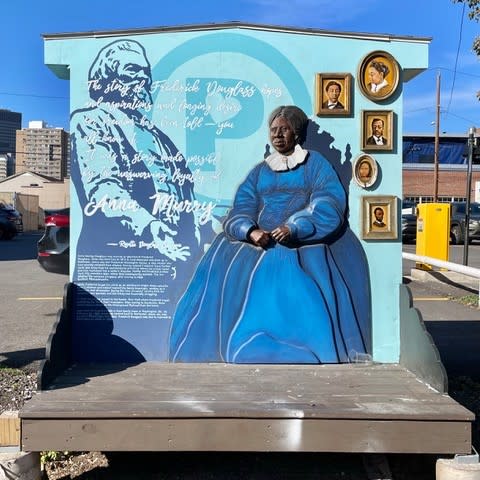
Anna Murray Douglass
“Elizabeth Blackwell”
Dr. Elizabeth Blackwell made history when she became the first woman to ever graduate medical school in the United States. She applied to Geneva Medical College in honor of a close friend who died, and was accepted as a joke. Ultimately, the joke was on the admissions team because Elizabeth graduated at the top of her class in 1849. Now, a statue of Elizabeth Blackwell sits on the quad of the renamed Hobart College in Geneva.
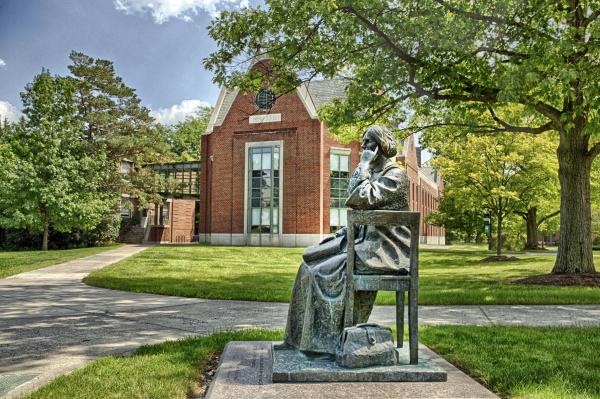
Dr. Elizabeth Blackwell
“The First Wave”
Featuring Elizabeth Cady Stanton, Jane Hunt, Mary Ann M’Clintock, Lucretia Mott, and Martha Coffin Wright, among others.
Step inside the Women’s Rights National Historical Park in Seneca Falls and you’ll be among some of the most influential women – and men – in the gender equality movement. Life-size bronze sculptures of Elizabeth Cady Stanton, Jane Hunt, Mary Ann M’Clintock, Lucretia Mott, and Martha Coffin Wright represent the five women who organized the first Women’s Rights Convention in 1848.
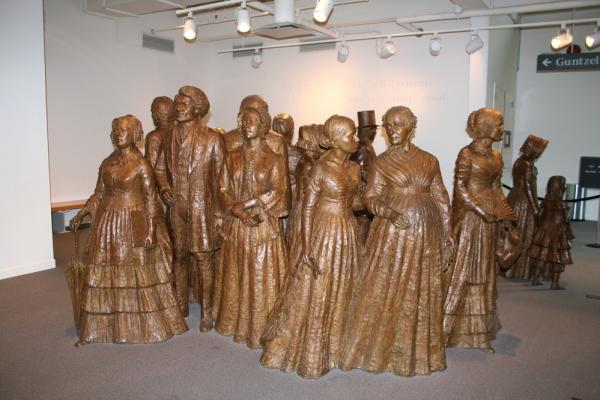
The First Wave
“Harriet Tubman”
Unveiled in 2018, the Harriet Tubman statue honors the legacy of a woman beloved both locally and nationally. Throughout her life, Harriet helped so many freedom seekers reach safety. Located at the NYS Equal Rights Heritage Center, the statue of Harriet resides just down the street from her home in Auburn.
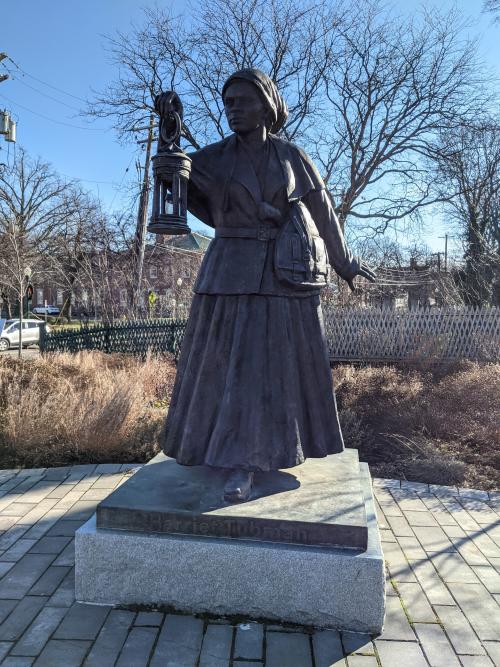
Harriet Tubman
“Let’s Have Tea”
Featuring Susan B. Anthony & Frederick Douglass.
Just down the street from the National Susan B. Anthony Museum & House in Rochester, you’ll find Susan B. Anthony Square. At the center of the park is Pepsy Kettavong’s statue “Let’s Have Tea”, featuring Susan B. Anthony and Frederick Douglass. The two activists, both wanting for more civil rights, became close friends despite their differences as a white woman and a black man. Together, Susan and Frederick rallied against slavery and advocated for women’s rights. The sculpture depicts a typical meeting between the pair.
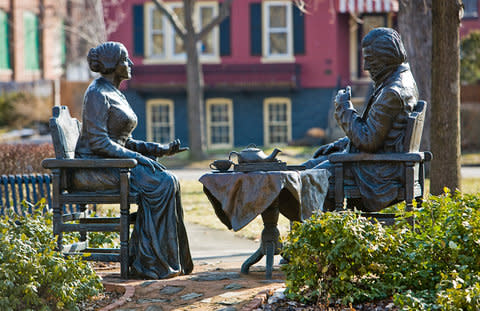
Let’s Have Tea
“Ripples of Change”
Featuring Laura Cornelius Kellogg, Sojourner Truth, Harriet Tubman, and Martha Coffin Wright.
Dedicated on September 24th, 2021, “Ripples of Change” depicts four women who crusaded for women’s rights. While all four women have ties to Seneca Falls, they each brought their own experiences and struggles to their advocacy for women. Their legacies live on as they are sculpted in this moment that sits along the water’s edge in Seneca Falls.
The artist, Jane DeDecker, explains the title of the piece, “The ripple phenomenon, a perpetual cascading occurrence when an object interrupts the waves of the water, offered an artistic solution to honor the continuous reverberation of the woman suffragists.” Not only where those reverberations felt a century ago, they are still making an impact today.
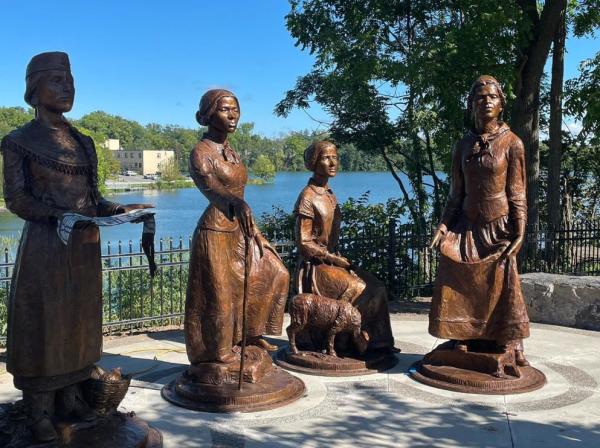
Ripples of Change
“When Anthony Met Stanton”
Featuring Susan B. Anthony, Amelia Bloomer, and Elizabeth Cady Stanton.
The two most famous people from the women’s suffrage movement are undoubtedly Susan B. Anthony and Elizabeth Cady Stanton. “When Anthony Met Stanton” was designed by Ted Aub and is located along the water in Seneca Falls. The work of art depicts their initial meeting.
On the evening of May 12, 1851, Elizabeth was leaving an anti-slavery meeting. Along her walk home, she came across her friend Amelia Bloomer, who then introduced her to Susan. From that night on, the two became fierce allies in the fight against slavery and for women’s rights. The rest is, quite literally, history.
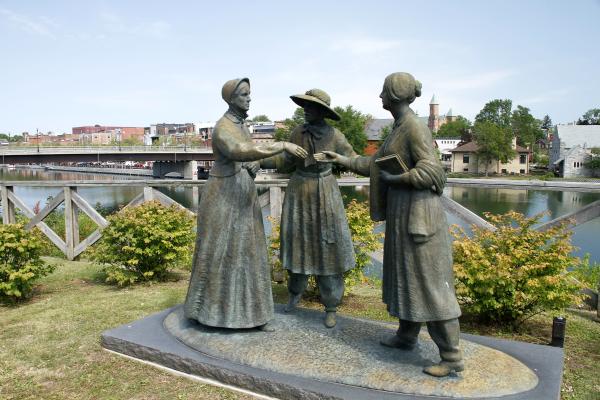
When Anthony Met Stanton
“Yoin jot geh cot”
Featuring an unnamed Indigenous family.
Located at the Ganondagan State Historic Site in Victor, this statue represents an indigenous family. Designed and sculpted by Peter B. Jones, “Yoin jot geh cot” was created to honor the donors of the Seneca Bark Longhouse Project. Artwork like this helps show visitors to the historic site what the local people and their culture were like before the Europeans settled in the area.
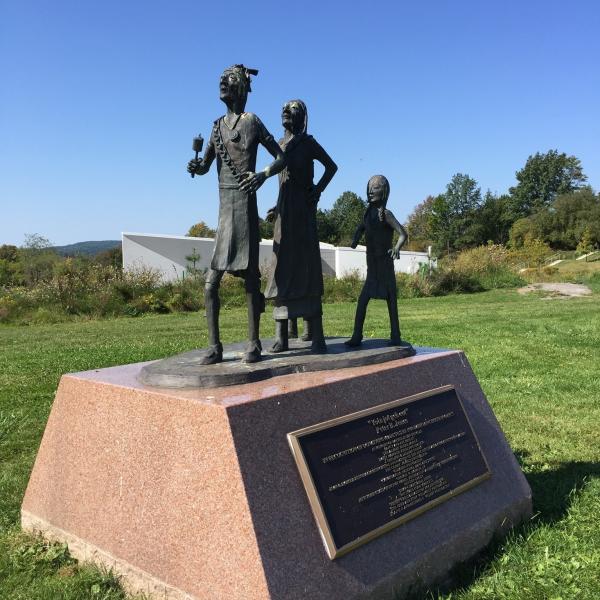
Source: Ganondogan State Historic Site



